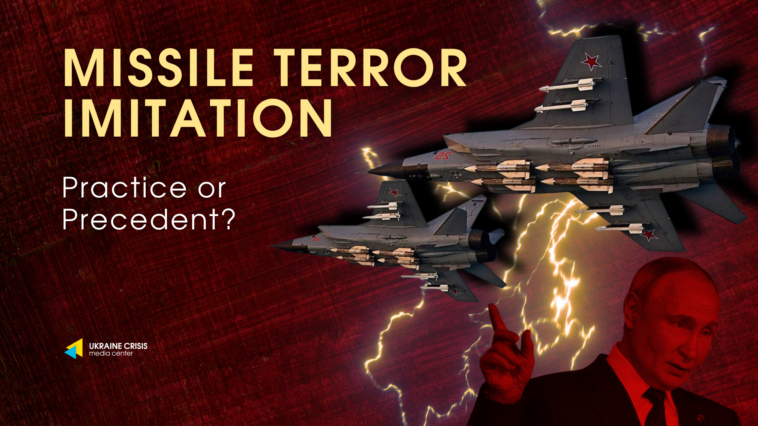Written by Matt Wickham
This morning, November 11, Russia conducted a large-scale exercise, simulating missile launches with eight MiG-31 jets and 13 Tu-95 bombers. In response, energy infrastructure was temporarily shut down as a precaution.
But why go to the trouble of a launch imitation? Or was it a rehearsal of what’s to come?
Message to the U.S. President-elect
Monday morning’s “on second thoughts” missile launch could be seen as a calculated show of power by the Russian president, coming less than 10 hours after reports emerged that the U.S. President-elect had spoken with Putin (although denied by the Kremlin).
Putin seems to be sending a message: “This is what I could do if I wanted.” Holding back at the last moment may be his way of signalling to Trump that, for now, he’s willing to uphold his end of the bargain. This move serves as both a reminder of the Kremlin’s potential for destruction and a nod to the supposed “deal” Trump’s team told he made in holding off targeting Ukraine’s energy infrastructure.
This assessment is reinforced by the timing of events. Although the leaders’ conversation occurred on November 7, it wasn’t reported in Western media until the evening of November 10, just hours before the mass Russian jet takeoff the following morning.
Organising such a display typically requires less time than a full-scale strike; the extra time usually needed to arm and configure missiles wouldn’t have been needed. The Kremlin could have effectively had its air force on standby, waiting for the news of their conversation to break and thus able to react at a moment’s notice.
Preparing for Sub-Zero Temperatures: Test Run
As colder weather intensifies the impact of infrastructure strikes, today’s flight might have served as a test run for when the Ukrainian winter truly hits. The Kremlin understands that in order to make the most of these costly strikes, it must deploy them in large numbers and multiple waves, given the years-long buildup of Ukraine’s now advanced, heavily tested air defenses.
Currently, Kyiv’s temperature is around 3-6°C, with a forecasted rise to 10°C next week. Until temperatures drop further, the Kremlin knows the impact won’t have that devastating blow, as Ukraine will likely restore infrastructure before the next strike.
Russia is likely biding its time, waiting for temperatures to fall below freezing for maximum disruption. December, especially around the holidays, looks like the most probable window for intensified strikes, similarly to the beginning of this year.
Stockpile Readiness Check
While Iran has supplied short-range ballistic missiles, primarily for targeting the front lines, the exact volume and nature of missile deliveries from North Korea remain uncertain. And so, for now, when conducting nationwide strikes, Russia has to rely on its own manufacturing capabilities.
A Ukrainian intelligence official told Forbes Ukraine that Russia can produce 42 to 56 ballistic missiles and 90 to 115 long-range cruise missiles. Considering the last nationwide strike took place on September 2, and a strike of an even larger scale one week earlier, at least over 70 days have passed. This has given Russia enough time to accumulate a sizable missile stockpile based on this data.
Reserve Major Oleksii Hetman of the Ukrainian National Guard noted that Russia may have produced at least 200 to 300 more missiles since the August 26-27 attack—an increase from the over 200 airborne targets used during that strike.
MiG-31Ks Are Back and Operational?
MiG activity had noticeably declined over the past two months. The lack of training flights and reduced deployment in the September 2nd attack could trace back to a successful Ukrainian drone strike in mid-August 2024, with sources from the SBU reporting damage to several MiG-31s stationed at Russia’s Savasleyka airbase.
Following Ukraine’s successful August drone attack, experts noted that securing fuel and lubricants for the MiG-31s stationed at these bases posed challenges, complicating Russia’s repair efforts. Three months later, it seems Russia may have bypassed these logistical difficulties.
The appearance of eight jets, potentially its entire remaining fleet of this craft, suggests Russia managed to repair some, if not all, the damaged, considering none of these jets would be new additions; Russia no longer manufactures MiG-31K engines. However, the full extent of their operational capacity remains unclear.
Russia is, in part, signalling its strength to the new U.S. president-elect, demonstrating “restraint” as a form of readiness, and setting the stage for negotiations rooted in intimidation and escalation. The Kremlin wants to secure the upper hand when and if there are talks, which, with it having the initiative on the battlefield, it currently holds.
However, as Ukraine knows all too well, the Russian leader doesn’t need an excuse to show his “power.” Today’s exercise could be nothing more than preparation for what’s to come as temperatures drop. Russia is gradually building pressure, hoping to bring Ukraine to the breaking point where it will feel it necessary to agree to unfavourable negotiations. This strategy has been increasingly evident with the escalation of drone attacks over the past two months, and now missile terror is being added as another layer of pressure.

